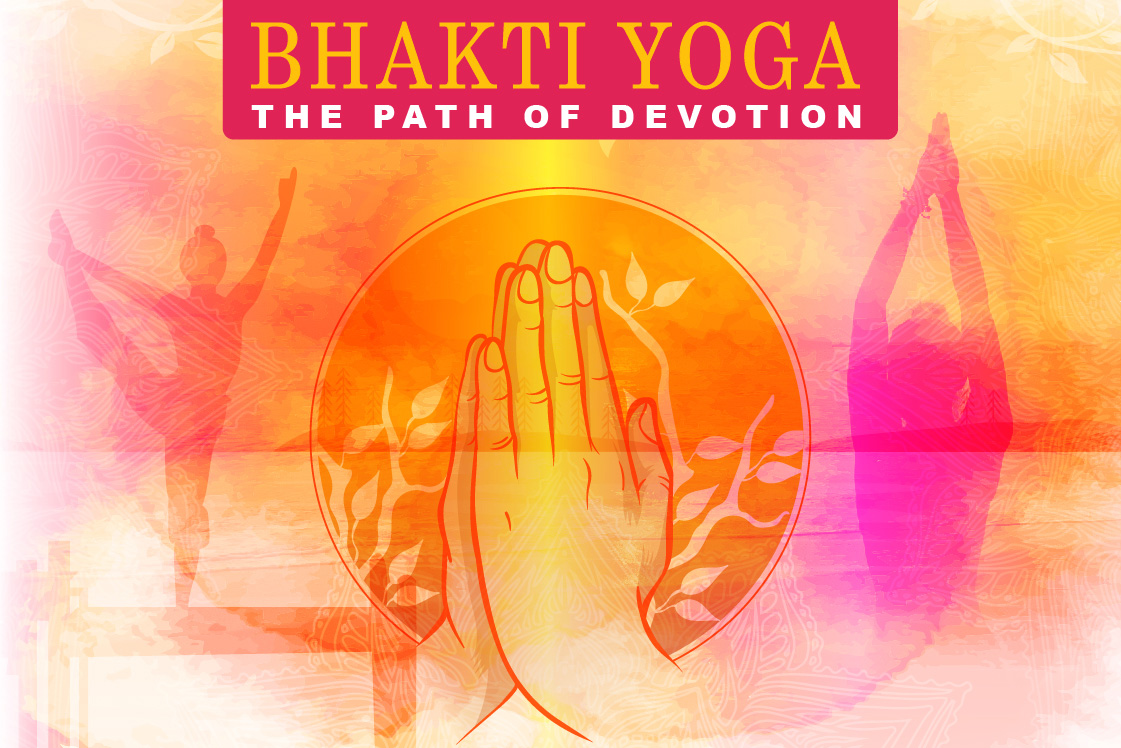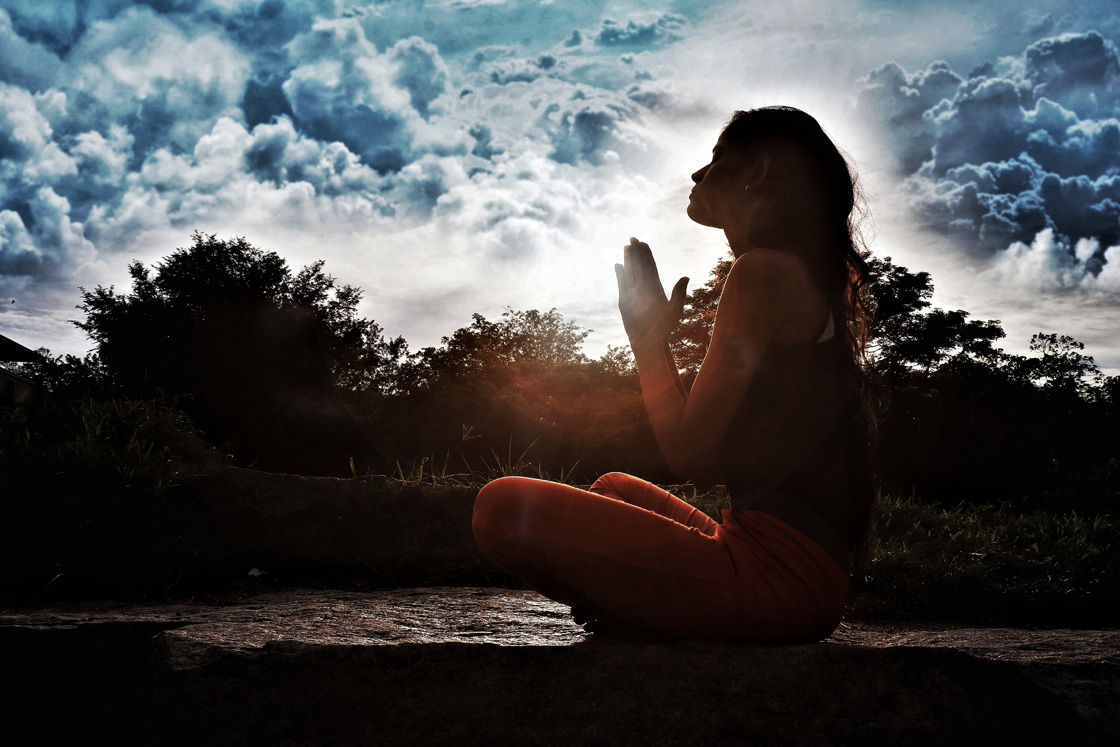
The goal of human life is to seek the realization of the ultimate truth and connect with the divine. Yoga aims to first bring us back to our true nature which is the soul (Atma) and then connects the soul with the Divine (Paramata).
There are various paths to attainment of the union with the Divine, however, the ultimate reality is only one. Every individual is gifted with the same set of assets as body, mind, intellect, and heart. However, every human being has different personality traits.
- Some individuals are physically & mentally very active while others are more contemplative.
- Some individuals operate more from the heart and are very emotional while others follow a pragmatic approach towards life.
Hence, there are various paths of Yoga for each personality type i.e. four paths of yoga:
1) Karma Yoga – The path of action (selfless service)
2) Bhakti Yoga – The path of love and surrender
3) Jnana Yoga – The path of knowledge
4) Raja Yoga – The path of the mind and meditation
People who are emotional, loving and devotional mostly follow the path of Bhakti Yoga. So, first, let’s know what is the Bhakti.
What is Bhakti?
Whoever offers Me with devotion a leaf, a flower, a fruit or a little water – that, so offered devotedly by the pure-minded, I accept ~ Bhagavad Gita 9.26
Bhakti originates from the Sanskrit word “Bhaj,” meaning love, attachment, faith, devotion, and prayer. It represents a deep and intense love of the devotee for the Divine. Bhakti is pure, unselfish, and beautiful, where the devotee feels connected with God in every breath, loving God without fear or selfish expectations—this is called “Parama Prem Rupa.”
Bhakti Yoga: Union Through Love
We already know, the meaning of yoga is union and the Bhakti is simply devotion or love for God. So, combining these two terms together can give a clear image of Bhakti yoga.
Bhakti Yoga is a spiritual path to liberation by uniting one’s Atman (true self) with the Brahman (true reality) through intense love for God. It involves making Divine the center of all your worldly activities. Through all these worldly activities, the devotee builds an intimate relationship with God where he sees the divine manifestation in all creation.
The major bhakti movement evolved in ancient India gives rise to the path of Bhakti yoga as a way to liberate from the birth and death cycle. Let’s know more about it in the history of Bahkti yoga.
History of Bhakti Yoga
Bhakti Yoga is the oldest form of Yoga with its roots in the ancient Indian scriptures like Shvetashvatara Upanishad, Bhagavad-Gita, and Bhagavad-Purana. However, it was only after the composition of Bhagavad-Gita around 500 B.C that Bhakti Yoga was recognized as one of the paths to liberation (Moksha).
In the past, Bhakti Yoga was the focal point of the widespread Bhakti movement initiated by religious reformers of medieval India (800-1700 BCE) to revive and reconceptualize various religious practices associated with the worship of God by Hindus, Muslims, and Sikhs.
Major reformers of the Bhakti movements were Shankaracharya, Chaitanya Mahaprabhu, Namadeva, Tukaram, and Jayadeva. Saints such as Bhagat Namdev, and Saint ‘Kabir Das’ were the supporters of this movement.
Major reforms of the Bhakti movement:
- Abolition of idol worship
- Demolition of cult and unnecessary ritualism
- Propagation of devotion based on love
- Introduction of free will to worship God of choice (Ishta-devta-Rama, Krishna, Vishnu etc)
- The opposition of caste, gender biases in spiritual paths
- Preaching unity of God and equality for all religions.
- Introducing new rituals of bhakti such as Kirtan (at Hindu temple), Qawaali (at Mosque) and Gurubani (at Gurudwara).
- Propagation of chanting for attaining liberation.
All major scriptures such as Bhagavad Gita, Bhagavata Purana, and Padma Purana were propounded during Bhakti movement.
Here we have described bhakti in the context of various Hindu traditions which evolved in the past.
Bhakti In Context of Various Hindu Traditions
Different devotees follow different personal God or Goddess according to one’s faith such as Krishna, Radha, Shiva, Vishnu, Saraswati, Durga, & Sita.
There are mainly four teaching traditions (denominations) or devotional sections in Hinduism based on the worship of different deities such as Vishnu, Shiva, and Shakti.
- Vaishnavism /Vaishnava Bhakti
- Shaivism /Saiva Siddhanta
- Shaktism /Shakti Bhakti
- Smartism /Panchayatana puja
1. Vaishnavism – Devotee of Vishnu
Devotees of Vaishnavism worship God Vishnu as the Supreme God. They also worship Vishnu’s ten incarnations (Avatars) out of which the two most-revered ones are Krishna and Rama.
2. Shaivism – Devotee of Shiva
Devotees of Shaivism known as Shaivas or Shaivities believe in Shiva as the Supreme God. Shaivites pray various forms of Shiva such as Natraja (Cosmic Dancer), linga (Immeasurable) and many more. There are twelve manifestations of Shiva.
3. Shaktism – Devotee of Shakti
Devotees of Shakti (Devi) known as Shaktas worship Goddess Shakti in different forms such as Kali, Lakshmi, Durga, and Saraswati.
4. Smartism – Devotee of All God
The branch of Hinduism treats all deities as same is called Smartism. This tradition follows two ideas of God (Brahman) which are the saguna Brahman and nirguna Brahman.
Sagun Brahman means divine with attributes like shape, color, size and nirguna Brahman means the Brahman without attributes. The ultimate reality is the Nirguna Brahman; however, Saguna Brahman is considered a means to attain the ultimate divine.
A devotee can focus on any deity such as Vishnu, Shiva, Surya in the practice period. Once the aspirant has achieved significant command in his spiritual pursuits, his attention will eventually start focusing on the true nature of ultimate reality and he will attain union with the Brahman.
According to this Hindu tradition, temples must include all five deities (Panchodevata) as a personal manifestation (divine with form saguna) of the Absolute, the Brahman (formless, nirguna). This tradition treats all deities as equal and the devotee can choose any deity according to his faith. It also includes other deities such as Ganesha and Surya.
Types of Bhakti Yoga
Basically, types of Bhakti yoga defines by how many types one can devote thyself to God.
So, There are the following 6 types of bhakti on which we can classify Bhakti yoga.
- Apara (lower) and Para (higher) Bhakti
- Ragatmika (bhakti without rituals) and Vidhi Bhakti (bhakti with rituals)
- Sakamya (devotion with desires) and Nishkamya Bhakti (selfless devotion)
- Vyabhicharini (devotion for both worldly attachments and God) and Avyabhicharini Bhakti (devotion only for God)
- Mukhya (primary) and Gauna (secondary) Bhakti
- Sattvic, Rajasic and Tamasic Bhakti
1. Apara and Para Bhakti
Apara bhakti is the lower form of devotion where the devotee worships only his favorite God through all rituals and ceremonies. This idea of devotion is very narrow as the devotee disregards all other forms of God. This is rooted in desires and ego.
Para bhakti is the highest form of love for God which is pure and without selfish desires. A devotee loves God for the sake of love and always want to serve the Lord without any expectations. Para bhakti recognizes the transcendental nature of God.
2. Ragatmika bhakti and Vidhi Bhakti
Ragatmika bhakti is a free flow of love for God without observance of any rituals and ceremonies. Vidhi bhakti is devotion which follows rules, rituals, and ceremonies.
3. Sakamya and Nishkamya Bhakti
Sakamya bhakti involves worshipping God to fulfill personal desires of health, wealth, and other material gains. God grants all wishes if the devotion is intense and prayers are done with genuine heart. However, the devotee never gets ultimate satisfaction and liberation through Sakamya bhakti because there is always a selfish desire and the love for God is not unconditional.
Nishkamya Bhakti is the highest form of bhakti one should aspire for. Here, the devotees love God with the purest heart without any desires and feel his presence at all times. The divine grace bestows upon the devotee and he gets all the divine gifts (wisdom, power etc) from God without asking anything.
4. Vyabhicharini and Avyabhicharini Bhakti
In Vyabhicharini Bhakti, devotee’s love is divided among family, material possessions and God.
In Avyabhicharini Bhakti, the devotee loves only God.
5. Mukhya and Gauna Bhakti
In Mukhya (primary) bhakti, God is the primary aspect of devotee’s life. And devotee’s love for God is pure and spontaneous.
Guana (secondary) Bhakti is devotion as a secondary aspect of devotee’s life and he loves God according to his attributes or Gunas.
6. Sattvic, Rajasic and Tamasic Bhakti
Sattvic Bhakti involves devotion to please God. The seeker only aspires for God and has no desires for materialistic concerns.
Rajasic Bhakti involves devotion to seek material riches.
Tamasic Bhakti involves devotion to achieve success through unfair means.
For example, a thief praying to God for success in a robbery.
A devotee should aspire to progress from lower forms to higher forms of Bhakti (Para Bhakti) where he loves God without any desires.
Based on different types of Bhakti, there are also different types of devotee (Bhakt).
Types of Devotee (Bhakt) in Bhakti
Four types of men begin to render devotional service unto me (God) — the distressed, the inquisitive, the seeker of material wealth, and the one who has already realized knowledge of the Absolute ~ Bhagavad Gita, chapter 7
A simple analogy to understand the types of devotee is:
A river gives water to everyone, however, how much water you get depends upon your vessel. Similarly, God has equal love for all beings. However, based upon unique temperaments of all individuals, each devotee has a different experience of the divine love.
People approach God for different reasons. According to Bhagavad Gita, there are four types of devotees:
- Artha (the distressed)
- Artharthi (the seeker of material wealth)
- Jijnasu (the inquisitive)
- Jnani (the self-realized)
1. Artha Devotee
Artha devotees remember God to alleviate suffering. When the problems get solved, these devotees again go back to their state of doubt about the existence of God.
2. Artharthi Devotee
Artharthi devotees want material things like wealth, family, fame from God. Their devotion to God is for the fulfillment of desires and wishes.
3. Jijnasu Devotee
A jijnasu is curious to know about God through inquiry and study of scriptures.
4. Jnani Devotee
Jnani bhaktas are self-realized devotees who know the ultimate truth of life i.e. God (Brahman). They are in touch with their divine nature and totally immersed in the love of God.
How Bhakti/Love Develops for God
Faith is the starting point of love and devotion. First, a devotee feels absolute faith in his God. Then, the devotee feels intense admiration and attraction for the Creator (God ). He gets drawn more and more to know, worship, pray and love God. Gradually, all his mundane worldly desires drop and he feels contentment and single-mindedness. Once that level of devotion is reached, the devotee lives every moment of his life in remembrance of God.
In the highest level of Bhakti, all attachments of the devotee with worldly objects fade and he feels attracted only towards God. This leads to a state where devotee feels one with God.
There are 9 stages in which devotion (Bhakti) develops in Bhakti yoga in a person.
9 Stage Process for Developing Devotion to God
- Shraddha – Faith
- Satsanga – Associate with devotees and spiritually advanced people
- Bhajana-kriya – Perform and participate in devotional service
- Anartha-nivrttih – Become free from unwanted material desires
- Nishta – Stability in devotional practice
- Ruchi – Develop a taste for bhakti
- Asakti – Develop attachment to God
- Bhava – Feels various emotions of love for God
- Prema – Pure love for Krishna.
According to Bhakti-rasamrta-sindhu, the process of Bhakti Yoga is explained as under:
Bhakti starts with a desire to know God. In the beginning, there must be faith. Then a devotee starts associating with Saints and Sages to advance in his spiritual journey. Thereafter, a devotee becomes initiated by a spiritual master under whose guidance he performs all devotional service. Through devotional service, the devotee’s heart is purified and he becomes free from unnecessary material desires. Once a devotee becomes free from desires, his attention on God becomes steady which helps him to further develop a taste for hearing and talking about God.
Gradually, the devotee becomes attached to God and he starts feeling different kinds of emotions of love for God. This is the preliminary stage of pure love for God.
Finally, a devotee reaches the final stage of Bhakti where he feels one with the Divine. This is stage of pure love for God known as Prema.
5 Emotions of Bhakti
When it comes to practice Bhakti yoga, the first thing pops up in the mind the is our emotions. In devotion, a person has the following 5 kinds of emotions which plays a very important role in the practice of bhakti-yoga.
- Shanta – Peaceful emotion
- Dasya – Servant devotee
- Sakhya – Friend Attitude
- Vatsalya – Motherly emotion
- Madhurya – Beloved emotion
These emotions (bhavas) represent different mental attitudes which a devotee can take while experiencing his relationship with God. A devotee can love God like a friend, a loyal servant, a loving mother, and a beloved.
Practice Bhakti yoga in whichever emotion suits your temperament.
1. Shanta Bhava
The devotee is calm, poised and peaceful. He does not exhibit many emotions, however, his heart is full of intense devotion. He silently and peacefully loves God with his heart full of love and joy.
Example: Bhishma. All renunciants have Shanta Bhava.
2. Dasya Bhakta (Devotee)
When a devotee aspires to serve God whole-heartedly with a servant attitude, this is known as Dasya Bhav.
Example: Sri Hanuman used to serve Lord Rama whole-heartedly like a faithful servant. He found joy and bliss in the service of his Master In the holy city of Ayodhya, the vast majority of people worship God with dasya bhava. Their names are like Ram Das, Siyaram Das.
3. Sakhya Bhava
In Sakhya Bhava, the devotee loves God like a friend.
This bhava is difficult to experience as devotee and God are on equal terms as friends. This bhava demands purity, understanding, openness, and courage to experience a relationship of a deeply intimate friendship with God. This Bhava can be attained only by people who are very mature and developed in Bhakti.
Example: Relationship between Arjuna and Lord Krishna.
4. Vatsalya Bhava
The devotee loves God as his little child. The devotee loses all fears and selfish desires in this Bhava as a mother cannot be afraid of her loving child. Nor can she expect anything from a small son.
Example: Yashoda’s love for her son, little Krishna.
5. Madhurya Bhava
In Madhurya Bhav, the devotee shares a relationship of the lover and the beloved with God. This is the highest form of Bhakti. The devotee and God feel one with each other while still being separate. Madhurya Bhav is totally different from earthly love as the former is selfless love for Divine while the latter is a selfish based on ego needs.
Example: Lord Gauranga, Jayadeva, Mira, Andal and many more.
On summing up all the emotions in Bhakti yoga, there are 9 ways to practice the Bhakti yoga for different kinds of practitioners.
9 Ways to Practice Bhakti Yoga

Devotion to God can be developed in nine different ways. A devotee can choose any method from the guide provided below, which suits him/her the best.
1. Sravana – Listening to God’s Stories
Sarvana is hearing of God’s stories from learned and wise men. When a devotee gets absorbed in hearing of Divine stories, his mind merges in the thought of divinity and loses charm for the material world. A devotee should sit with learned teachers and hear the preaching of the scriptures.
Example: Parikshit attained liberation through this mode of Bhakti.
2. Kirtana – Chanting /singing of His Glories
Kirtana is singing of God’s praises with a pure heart. The devotee’s mind is always inclined towards singing God’s glories and has no interest in the worldly concerns. Kirtana purifies the heart and dissolves the ego. Devotional music, dance, chanting and reading scriptures are all part of the Kirtana.
Example: Sukadeva Goswami narrated Bhagavatam to Maharaja Pariksit.
3. Smarana – Remembrance of His Name and Presence
Smarana means remembering God at all times. Chanting, hearing of stories relating to God, talking to God, teaching others about God, a meditation on the attributes of God etc is all part of the remembrance of God. The devotee’s mind constantly meditates on glories of God, his virtues, Names and he gets absorbed in the love for God.
Example: Prahlada never forgot Krishna despite all tortures from his father.
4. Padsasevana – Service of His Feet
Pad means feet. Padasevana is serving the Lord’s feet. Padasevana can be done only by Goddess Lakshmi or Parvati. No mortal being is bestowed with the fortune to perform this form of Bhakti as God is not visible to the physical eyes. A devotee can serve the Lord’s feet through the worship of the idols in temples or mental image of God.
Another way to do Padasevana is to serve the sick, needy and poor. By serving humanity, a devotee provides service to God.
Example: Goddess Laxmi serves the feet of the Lord.
5. Archana – Worship of God
Archana means the worship of God. Worship can be done either through an image or mental form. A devotee can worship with external objects like flowers, candles, fruits or simply through deep internal emotion. A devotee attains the highest form of worship when he considers all creatures as God and serves them as a gesture of service to God. God appears in all forms. Serving the poor and worshipping saints purifies the heart through the surrender of ego and love of God.
Example: King Prthu offered all his royal possessions in pure devotion to the Lord.
6. Vandana – Prostration to Lord
Through prayers and prostration to God, one’s ego gets dissolved completely, the Divine Grace descends upon the devotee and man becomes God.
Example: Akura was deeply immersed in prayers of Lord Krishna throughout his journey to Vrindavan.
The Bhagavata says:
The sky, air, fire, water, earth, stars, planets, the cardinal points (directions), trees, rivers, seas, and all living beings constitute the body of Sri Hari. The devotee should bow before everything in absolute devotion, thinking that he is bowing before God Himself.”
Lord Krishna says to Uddhava: “Giving no attention to those who laugh in ridicule, forgetting the body and insensible to shame, one should prostrate and bow down to all beings, even to the dog, the ass, the Chandala and the cow. All is Me, and nothing is but Myself.
7. Dasya – Cultivating the Bhava of a servant for God
A devotee loves God like a faithful servant. Worshipping the idols in temples, cleaning the temples, serving the saints and devotees, and serving the sick and poor who are forms of God is part of Dasya Bhakti.
A dasya (servant) bhakt follows the scriptures and acts according to the instructions of the Vedas considering them to be direct words of God. He is always involved in serving the devotees, saints, and sages who have knowledge of God. A dasya bhakt (devotee) aspires to always be with God so that he can serve him whole-heartedly, win His Divine Grace and thereby, attain liberation.
Example: Hanuman, worshipped Lord Rama like a loving servant. He would fulfill all his commands despite all difficulties.
8. Sakhya – Cultivation of the Friend-Bhava
Sakhya-Bhava involves devotion to God with the sentiment of a friend. The devotee’s relationship with God has the same dynamics as experienced in close friendships. The devotee shares a very deep and intimate bond with God.
Example: Intimate friendship bond between Arjuna and Lord Krishna.
Arjuna was so close to Krishna that the Lord offered Himself to become his chariot driver and serve Arjuna and his brothers in various ways.
“Oh, how wonderful is the fortune of the people of Vraja, of cowherd Nanda whose dear friend is the perfect, eternal Brahman of Absolute Bliss!”. Bhagavatam
9) Atmanivedana – Complete Surrender of the Self
Here, the devotee surrenders everything to God including his body, mind, and soul. He considers himself an instrument in the hands of God and hence, there is no sense of being or doership. Such a devotee loves God for the sake of only love and does not expect anything in return, not even liberation. He feels only the presence of God and his loving Grace.
Example: king Bali gave away his everything including body to Sri Vamanadeva even when his spiritual master was against it.
Benefits of Bhakti Yoga
When we follow the path of karma yoga, it automatically develops caring nature within us & with caring nature, one can enjoy the fruits of Bhakti yoga.
1. Less dependence on the external world
A devotee is less dependent upon the external world –relationships, situations, fame, money, etc. for love and happiness. He has found an ocean of eternal peace and love through his unselfish devotion to God.
2. Removes all doubts and fears
Bhakti removes all fears of the devotees, even the fear of death as a true devotee only aspires for the love of God and wants nothing else.
3. Cultivates compassion and love for everyone
A devotee has equal love for all beings as he sees the Divine in all forms of creation. All negative emotions arising out of Dvesha (strong dislike) evaporate. He cannot bear negativity for any living being even a poisonous snake. He will keep an appropriate distance from the source of pain, however mentally he will maintain the love for one and all.
4. Provides emotional and mental stability
A devotee remains neutral through the thick and thin of life and sees the difficult situations as a part of the process of spiritual growth. A true devotee sees all events of life as drama and result of Prarabdha Karma (Past life Karma experienced through present life). Hence, when things do not go as per plans and desires, a devotee never loses his emotional stability. There are no signs of anger and painful emotional outburst in a true devotee. He respects the opinions of others as different points of view.
5. Dissolves the ego
A true devotee has no attachment and sense of ownership for people, possessions not even his body. A devotee’s purpose of life to serve God and he feels an instrument in the hands of the Divine. He lives in a state of absolute surrender to God.
A bhakti yogi performs all worldly karma without any desires as he has found the eternal bliss and joy of the divine love in his heart. He is content within himself and hence, is not distracted by the power of worldly Maya.
6. Provide the ability to discriminate
A devotee develops an ability to discriminate between temporary happiness (Maya) and eternal joy (Divine love). A devotee observes and passes through all facets of the external world (pleasure, pain, beauty, novelty etc) without attachment. He knows the ever-changing reality of worldly happiness. Hence, a devotee knows that the knowledge of the ultimate reality, Brahman is the only security.
7. Purifies the heart
A devotee never feels envious to see anyone more blessed than him as he sees God in every being. He wishes good for one and all.
8. Improves confidence
A devotee is truly confident in him as he is and he never tries to please anyone. He is equanimous in all situations and gets along with all kinds of people and situations quite effortlessly.
Conclusion
The path of Bhakti yoga is easiest among 4 paths of yoga as it demands only one’s faith for divine and, everything else automatically begins working then. It dissolves impurities from practitioners Chitta, and replace it with love for the Divine self.
There are following suggested readings if you want to learn more about Bhakti yoga.
1. The practice of Bhakti Yoga by Sivananda
2. The Yoga of Spiritual Devotion: A Modern Translation of the Narada Bhakti Sutras by Prem Prakash
3. Bhakti-yoga by Swami Vivekananda
4. Narada’s Way of Divine Love: The Bhakti Sutras by Swami Prabhavananda
5. Bhakti and Philosophy by R. Singh
6. Bhakti-Yoga: The Yoga of Love and Devotion by Swami Vivekananda
7. The Nectar of Devotion: The Complete Science of Bhakti-Yoga by Swami A. C. Bhaktivedanta and A. C. Bhaktivedanta Swami
8. A Series of Lessons in Bhakti Yoga by Bhikshu





Beautiful and eye opening article.I worship all hindu gods and celebrated all pujas and festivals just like my parents did. This article inspired me and very helpful. Thanks a lot for the list of suggested readings.
Thank you for that formula..
It’s a nicer way to experience Life..
Success to all..!
Pranamaham!
Thanks a lot! ?